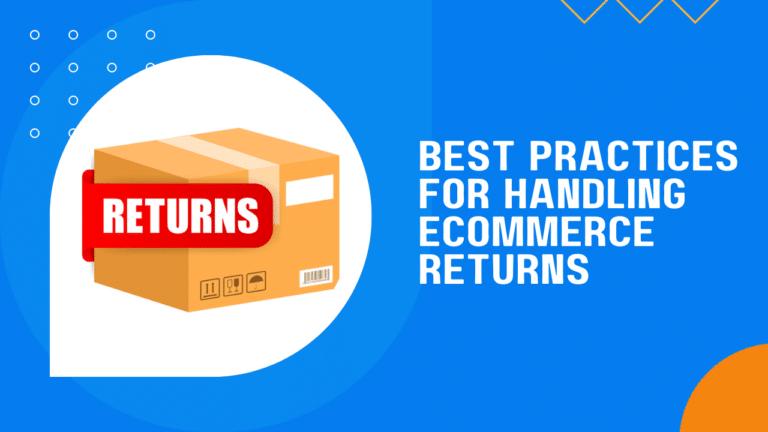Ecommerce customer returns present both challenges and opportunities for businesses. Effectively managing these returns goes beyond logistics; it’s about aligning with customer expectations, setting clear policies, and striving for continuous improvement. This article will explore best practices that benefit both businesses and their customers in the realm of returns.
The Challenges of Handling Returns

Logistical Issues
Managing returns in ecommerce isn’t just about accepting a returned product. It involves a series of steps, from receiving and inspecting the product to determining its resale value. Businesses must also decide whether to restock, refurbish, or dispose of the returned item. Each step requires resources, time, and can introduce potential errors or inefficiencies.
Impact on Revenue
Every returned product has financial implications. If the product is damaged or cannot be resold, it directly affects the bottom line. Additionally, the costs associated with return processing, such as shipping, handling, and inspection, can accumulate and impact profitability.
Customer Dissatisfaction
A seamless return process is crucial for maintaining customer trust. If customers find it difficult to return products, face delays, or don’t receive timely refunds, it can lead to dissatisfaction. Negative experiences can deter customers from future purchases and harm the brand’s reputation.
Operational Strain
High return rates can strain a business’s operations. It requires additional manpower to process returns, manage inventory, and handle customer queries. Over time, this can lead to operational bottlenecks and inefficiencies.
Feedback Management
Understanding why customers return products is vital. It offers insights into potential product improvements or changes in marketing strategies. However, collecting, analyzing, and acting on this feedback can be a complex and time-consuming process.
Return Fraud and Abuse
Some customers might exploit return policies by returning used or counterfeit products, or by engaging in “wardrobing” (buying products, using them once, and then returning them). This not only impacts revenue but can also increase operational costs.
Environmental Concerns
The return process can have environmental implications. Shipping returned products back and forth increases carbon footprints. Additionally, products that can’t be resold might end up in landfills, contributing to environmental waste.
Inventory Management
High return rates can disrupt inventory management. Predicting stock levels becomes challenging when a significant number of products are in the return pipeline. This can lead to stockouts or overstock situations.
Resource Allocation
Handling returns requires dedicated resources, both in terms of manpower and infrastructure. Businesses might need to set up dedicated return centers or hire additional staff, leading to increased operational costs.
Impact on Marketing and Sales
Frequent returns can signal issues with product quality, descriptions, or marketing strategies. It might necessitate revisiting product listings, updating descriptions, or even re-evaluating marketing campaigns.
Crafting a Customer-Friendly Return Policy
A well-structured return policy is the cornerstone of managing ecommerce returns effectively. It not only sets clear expectations for customers but also provides guidelines for businesses to handle returns efficiently. Here’s how to craft a policy that benefits both parties:
Transparency is Key
Clearly outline the terms and conditions of returns. Specify the duration within which returns are accepted, any associated fees, and the condition in which products should be returned. Avoid using jargon or complex language; the goal is to make the policy easily understandable.
Flexibility in Return Options
Offer multiple return options to cater to different customer preferences. This could include in-store returns, postal returns, or even third-party collection services. The easier you make the process, the more likely customers are to have a positive experience.
Prompt Refunds
Ensure that once a return is processed, refunds are initiated promptly. Whether it’s a credit to the original payment method or store credit, timely refunds enhance customer trust.
Detailed Product Descriptions
One of the primary reasons for returns is the product not matching customer expectations. Ensure that product listings have detailed descriptions, accurate images, and size guides to reduce the likelihood of returns.
Feedback Mechanism
Encourage customers to provide feedback on why they’re returning products. This not only helps address any underlying issues but also offers insights into potential improvements in product quality or descriptions.
Strategies to Enhance Customer Satisfaction During Returns
Ensuring a positive experience during the return process is crucial for retaining customer loyalty and trust. Here are some strategies businesses can adopt to enhance customer satisfaction:
Clear Communication
Keep customers informed at every step of the return process. Whether it’s acknowledging the receipt of a returned product, updating on the refund status, or providing reasons for any return rejections, clear communication can alleviate customer anxieties.
Easy Return Process

Simplify the return process by providing pre-printed return labels, easy-to-follow return instructions, and multiple return options. An intuitive and hassle-free process can significantly enhance the customer experience.
Quick Turnaround Time
Minimize the time taken to process returns and issue refunds. A swift turnaround can leave a positive impression, even if the customer wasn’t entirely satisfied with the product.
Accessible Customer Support
Ensure that customers can easily reach out for support during the return process. Whether it’s through chat, email, or phone, having accessible and responsive customer support can make a world of difference.
Leverage Technology
Use technology to streamline the return process. Implementing return management software can help track returns efficiently, automate certain processes, and provide valuable insights into return trends.
Logistical Solutions for Efficient Return Management
The logistical management of returns is a critical component that can significantly influence customer satisfaction and operational efficiency. Centralized return centers, for instance, play a pivotal role in expediting the processing of returned items. These dedicated facilities are equipped to handle tasks such as quality checks, restocking, and refurbishing, ensuring that products are swiftly reintroduced into the sales cycle.
Another strategy that has gained traction among ecommerce businesses is the inclusion of pre-paid return labels in the original shipment. This approach simplifies the return process for customers by eliminating the need for them to bear the initial return shipping costs and subsequently seek reimbursements. The convenience offered by this method can greatly enhance the overall customer experience.
Furthermore, the realm of reverse logistics offers a plethora of opportunities for optimization. By forging partnerships with logistics providers that specialize in this area, ecommerce businesses can streamline the return journey of products. These providers come equipped with the expertise and infrastructure necessary to handle returns with utmost efficiency, thereby reducing the overall turnaround time.
Real-time return tracking is another feature that can bolster transparency and trust between businesses and their customers. By allowing customers to monitor the status of their returns in real time, businesses can keep them informed about the progression of their return and set clear expectations regarding refund or exchange timelines.
Smart inventory management software is also crucial in the context of returns. By seamlessly integrating return management systems with inventory solutions, businesses can receive instantaneous updates on stock levels. This real-time synchronization ensures that as products are returned and restocked, inventory levels are adjusted accordingly, minimizing the risk of stock discrepancies.
For businesses that have a physical retail presence or collaborations with retail chains, the concept of return kiosks or designated drop-off points can be a game-changer. These points of return offer customers a convenient alternative to traditional return shipping methods and can expedite the refund or exchange process.
Lastly, integrating a feedback mechanism within the logistical framework of returns can yield invaluable insights. Understanding the reasons behind returns, whether they stem from product discrepancies, sizing issues, or other factors, can guide businesses in refining their offerings and enhancing the overall shopping experience.
Reducing Return Rates
Reducing return rates is a primary objective for many e-commerce businesses, not just from a cost perspective but also as a metric of customer satisfaction and product quality. Several strategies can be employed to achieve this:

Accurate Product Descriptions: One of the leading causes of returns is a mismatch between product expectations and reality. Ensuring that product descriptions are detailed, accurate, and reflective of the actual product can significantly reduce return rates. High-quality images, detailed specifications, and even customer reviews can provide potential buyers with a comprehensive understanding of the product.
Size Guides and Virtual Try-Ons: For businesses selling clothing or footwear, size discrepancies are a common reason for returns. Providing detailed size guides, measurement tools, or even virtual try-on features using augmented reality can help customers choose the right size the first time around.
Customer Feedback Analysis: Analyzing feedback from customers who have made returns can provide insights into recurring issues. Whether it’s a particular product line that’s often returned or a common complaint about a product feature, this feedback can guide product improvements and reduce future returns.
Enhanced Customer Support: Offering proactive customer support can help address potential return reasons before they arise. Whether it’s answering product-related queries, providing usage guidance, or assisting with setup, a responsive customer support team can mitigate reasons for returns.
Quality Control: Ensuring that products meet quality standards before they are shipped can reduce returns due to defects or damages. Regular quality checks, vendor assessments, and robust packaging can ensure that products reach customers in perfect condition.
Flexible Exchange Policies: Sometimes, customers might be satisfied with a product but prefer a different variant, color, or size. Offering flexible exchange policies can redirect potential returns into exchanges, benefiting both the customer and the business.
By implementing these strategies, ecommerce businesses can proactively reduce return rates, leading to increased customer satisfaction, reduced operational costs, and enhanced brand reputation.
Perfecting the Returns Process
In the dynamic world of ecommerce, returns are often viewed with apprehension. However, as we’ve explored throughout this article, they present a unique opportunity for businesses to strengthen customer relationships, refine product offerings, and drive sustainable growth. By adopting a proactive and customer-centric approach to returns, ecommerce businesses can transform this perceived challenge into a strategic advantage.
The key lies in understanding the underlying reasons for returns, leveraging technology to streamline the process, and continuously seeking feedback to improve. As businesses embrace returns as an integral part of the customer journey, they not only enhance customer satisfaction but also position themselves for long-term success in the competitive ecommerce landscape.
In the end, perfecting the return process is not just about managing product returns; it’s about building trust, fostering loyalty, and harnessing insights for continuous improvement. For ecommerce businesses aiming for excellence, returns are not a setback but a steppingstone to greater achievements.









